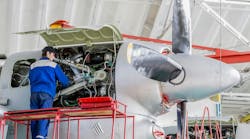FlexDecks Maintenance specializes in Modular Maintenance Stands to provide safe access to all aircraft types for daily and phased maintenance points.
Modular Maintenance Stands are constructed from lightweight, high-strength structural grade 6061 aluminum with self-draining decks, anti-slip and anti-bounce safety treads. The modules can be repositioned anywhere along the aircraft (with stairs on either end of the platform) and attachment points are tool-free. The stands are height adjustable up to 2 feet and available in heights (within the 24- to 36-inch adjustability) ranging from 56 to 126 inches.
Although there was a time when it seemed no two maintenance stands were alike, FlexDecks category manager Sheila Croff said today, the company’s Gen II stands are the same type of stand with a standard design and modular units. Nonetheless, “customizable” is not a word that the company steers away from.
“We do get customers need ‘customizable stands,’” Croff said.
Once customers specify their requirements, she said, “we take our pieces from our library and put them together to make the stand for the customer.”
All FlexDecks are commercial off the shelf (COTS). “If a customer calls me up and they need an additional handrail or want to add an additional deck to the stand they have, we pull all the parts together and ship them out to the customer with no hassle of additional measurements, verifying and reverifying,” she said. “The customer’s time is too valuable for us to bog them down with something we can easily do now with our Gen II design.”
Each month, FlexDecks produces 50 custom platforms and in most cases, FlexDecks can develop a solution from its existing platform catalog.
Customers may want stands that are wider, longer, more adjustable or maybe they want to add a davit system to the deck. Croff said, “We work with customers on all their needs.”
FlexDecks understands aircraft maintenance varies from aircraft to aircraft. Fixed wings, of course, have different requirement than helicopters. Some fixed wings may only need stands for re-work on the leading edge or the trailing edge of the wings. Others may need cockpit stands or engine stands. Helicopters require maintenance mainly the rotor heads, engines and tails.
And, each facility location is different, Croff said, depending on the type of maintenance required. Aircraft maintenance technicians face different space constraints, some of the spaces are ballroom-sized, others are much smaller.
“We always work with the end-users and verify their needs and ‘pains’ on what their requirements are,” she said. “We don’t assume what the customer is needing. We verify, verify, verify, supply drawings and ensure they are completely satisfied before we go into production.”
The overall fit, form and function of aircraft maintenance stands have remained unchanged as the outside of the aircraft has not changed. What has changed over time, Croff said are some of the maintenance stand features: adjustability, towing capabilities, and sliders or fingers that conform to the side of the aircraft. Also, options now include folding handrails, pneumatic air, electrical outlets, lighting, laptop trays and more.
FlexDecks was among the first, if not the first, to add powder coating handrails as a standard because of the oxidation of the aluminum and was favored by the industry, Croff said. Now, she said, “we offer powder coating for decks, stairs and sliders as an option to prolong the length of usage of the stand to many years of service.”
Among the most unique requests FlexDecks has received was for maintenance stands used during the production of aircraft. After production, the stands were then reconfigured to maintain the aircraft.
Another project was for a Lockheed U-2 nicknamed the ‘Dragon Lady,’ which has been flying since 1955.
“We manufactured stands so the aircraft can be completely disassembled and torn down to the frame then reassembled and built back up to being able to fly again,” Croff said. “The process takes several months and with the stands, it allows the users to have a comfortable ergonomic area to work on.”
By using maintenance stands, aircraft technicians can be at the height where maintenance is needed on the aircraft, and all their tooling and parts are on the deck of the stand. FlexDecks platforms have been found to reduce worker fatigue by 97 percent and maintenance time by 40 percent, and turnaround time on the aircraft can go from months to weeks.
When shopping for a maintenance platform, Croff said, “Do your homework on the company, cheaper is not always better. We find customers who have gone this route and either scrap the stands within a year or the stands don’t fit at all and the stands are unusable. Then they are shopping again for stands.”
Croff recommends ask for pictures, references, what makes one company stand out more than another. She said also ask about warranty, customer service and setup teams.
A lot of companies make stands, she said. “It really depends on what you want, need, requirements, usage, how much time will you be on this stand in a workday, what do you need to make your job easier,” she said. “FlexDecks takes pride in manufacturing the stands we deliver to our customers, we want to be the best, and we want our customers happy every time they look and work on our stands.”





